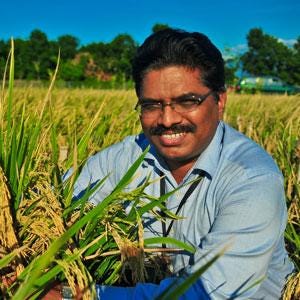Scientists at the Philippines-based International Rice Research Institute, with crucial support from the Bill and Melinda Gates Foundation, have wrapped up a successful 22-year campaign to revolutionize rice production, a massive project involving the efforts of hundreds of researchers in dozens of countries.
The project to produce what is called Green Super Rice is the successor to IRRI’s original IR8 project of the 1960s, which won agronomist Norman Borlaug the Nobel Prize and set off the Green Revolution that saved much of the world from starvation.
Asian cultivated rice, according to a research paper by multiple authors published by McMillan, is the world’s most important staple, producing food for half the global population. It is now more important than ever. An additional 112 million tonnes of rice are expected to be needed to be produced on shrinking land by 2035, using less water under substantially more unstable weather conditions due to climate change under multiple biotic and abiotic stresses to feed a population of 8.89 billion people – 1.01 billion more than today.
Begun in 1998, the Green Super Rice project commenced as an intensive, 12-year partnership between the Chinese Academy of Agricultural Sciences in Beijing and IRRI in Los Banos, south of Manila, which later took it over and has expanded it across much of Asia and into Africa. Some 56 varieties tailored to individual conditions have been introduced in 16 countries. More than 100 cultivars are still in the pipeline, although the Gates foundation has not agreed to fund a fourth phase of development.
Rather than manipulating genes, green super rice has been developed via the painstaking crossbreeding of 500 elite germplasms out of the 3,000 different rice genomes and hybrids in a campaign to produce plants that are hardy, resistant to traditional diseases without the use of pesticides or fertilizers and ready for market in record times, according to Dr. Jauhar Ali, the leader of the 85-member global Hybrid Rice Development Consortium and a senior scientist at IRRI.
 The original process was developed by Li Zhi-Kang, a senior molecular geneticist and chief scientist with the Institute of Crop Sciences at the Chinese Academy of Agricultural Sciences in Beijing, and executed by Jauhar Ali at IRRI across 16 countries. Today, according to Dr. Ali (pictured), GSR varieties are now planted on 3.1 million hectares outside of China by 2.4 million farmers out of 158 million hectares globally, but are expanding fast. Some 35 percent of the rice grown in Punjab, India’s breadbasket, is produced from GSR seeds. The GSR varieties have spread to 4.2 million hectares in five provinces of China as well.
The original process was developed by Li Zhi-Kang, a senior molecular geneticist and chief scientist with the Institute of Crop Sciences at the Chinese Academy of Agricultural Sciences in Beijing, and executed by Jauhar Ali at IRRI across 16 countries. Today, according to Dr. Ali (pictured), GSR varieties are now planted on 3.1 million hectares outside of China by 2.4 million farmers out of 158 million hectares globally, but are expanding fast. Some 35 percent of the rice grown in Punjab, India’s breadbasket, is produced from GSR seeds. The GSR varieties have spread to 4.2 million hectares in five provinces of China as well.
“It’s like – I don’t have the exact word, it is like a fulfillment,” Dr. Ali said in an interview. “It’s like, oh, we did it, we have had an impact, we are very happy.”
The development of the process, Dr. Ali said, was funded by US$41.5 million from the Gates Foundation. It is unique, because rather than demanding payment for new seed every year as major seed producers including DuPont, Syngenta and Monsanto do, GSR seeds are free. The project mandates farmers who are issued with GSR rice seeds to pass them on to as many as five of their nearby farming colleagues.
To give some idea of the complexity of the project, the rice scientists identified 29 million single nucleotide polymorphisms – commonly called “snips,” the most commonplace type of genetic variation representing a difference in a single DNA building block. They made 2.4 million small “indels,” a molecular biology term for an insertion or deletion of bases in the genome of an organism, and more than 90,000 structural variations contributing to population variations.
Green Super Rice doesn’t involve genetic modification. Instead, it involves taking hundreds of donor cultivars from dozens of different countries, identifying significant variations in plant response to drought, global warming and other problems, and “backcross” breeding – painstakingly crossing a hybrid with one of its parents or with a plant genetically like one of its parents, then screening the backcross bulk populations after one or two backcrosses under severe abiotic and biotic stress conditions to identify transgressive segregants that are doing better than both parents and the checks.
This operation is done for all the backcrosses originating from scores of recurrent parents and hundreds of donor plants and reconfirmed before further pooling them across different traits by the use of molecular markers to improve rice tolerance for drought, salinity, submergence, rice blast fungus, bacterial leaf blight and the ability to out-compete weeds, reducing the need for fertilizers.
The GSR rice proved its worth, according to Dr. Ali, in the wake of Typhoon Haiyan/Yolanda, which has been called one of the most powerful typhoons ever recorded. It devastated the central islands of the Philippines in November 2013, killing 6,300 people and affecting 14.1 million more. It devastated 600,000 hectares of farmland, causing US$700 million in damage to the agriculture sector. Waves of wind-driven seawater tore across Samar, Leyte and Cebu, inundating rice crops.
That was followed less than a month later by Typhoon Hagupit, called Ruby in the Philippines, killing 26 more and causing US$114 million in damage in the same area, once again inundating riceland with saltwater.
“What happened, when you had Haiyan, at that time our project gave seed to the [Philippine Department of Agriculture] to help farmers in the region,” Dr. Ali said. “Then Hagupit came through and destroyed many of the nurseries and the seed we had given them. So much of the acreage was devastated.”
IRRI gave two tons of GSR seeds and farmers in Leyte produced 170 tons of a high-salt-tolerant strain of the rice called GSR 11 and shared with other farmers in the region. To everybody’s surprise, the Leyte farmers managed to produce excellent crops. Today, Dr. Ali said, GSR 11 is one of the dominant varieties being cultivated by Leyte farmers almost immediately. More than a million hectares of the Philippines are now planted in GSR varieties, turning the Philippines from import-dependent to self-sufficient, Dr. Ali said.
That kind of success has been replicated across much of Asia, in India, Bangladesh, Vietnam and other countries. In Indonesia, GSR varieties have been planted to reduce the devastation without pesticides of the brown planthopper, Nilaparvata lugens, which has produced severe yield losses in 11 other Asian countries as well.
“We found it was not only [planthopper] resistant but drought-tolerant,” Ali said. Areas of Indonesia using the GSR strains “are expanding quickly and have given a lot of boost to the situation there.”
The beginnings of a green revolution
It has been 54 years since IRRI, established by the Philippine government and the Ford and Rockefeller Foundations, introduced IR8, the first “miracle rice,” as it was called then, to the world, at a time when India especially was on the brink of mass starvation. IR8, a semi-dwarf variety, yielded about 5 metric tons per hectare without fertilizer and as much as 10 tons under optimal conditions – about 10 times the yield of traditional rice.
IR8 was subject to kernel breakage and other problems. But eventually, its successors revolutionized world food production, driving down the price of rice by more than 50 percent and turning India, Thailand and other countries into some of the world’s most successful producers and exporters. The Philippines, where IR8 was developed, became rice sufficient for several decades, with production increasing from 3.76 million tons to 7.7 million in two decades, before slipping into deficit again as the country’s agriculture programs deteriorated under corrupt and inefficient governments.
Rice production typically consumes two to three times as much water as do other cereals. Thus water deficiency – drought – has been the single biggest limit in rain-fed rice fields, with drought at the early stages of growth causing delayed transplant or delayed germination. Drought at the reproductive stage also slows growth, according to a variety of papers made available by Dr. Ali, resulting in low and unstable rice productivity. Also, IR8 yields have dropped by about 15 percent as hotter nights produced by climate change impeded growth.
IR8’s successors used far more fertilizers and pesticides than conventional strains, but produced substantially higher yields. The extensive back-crossbreeding, which was developed by Li Zhi-Kang when he was a researcher at IRRI before moving back to Beijing, was partly developed as an effort to reduce the dependency of the new rice strains on fertilizers and pesticides. It appears to be succeeding.
Although there are modest improvements in yield averaging around 5 percent, according to Dr. Ali, yield improvement is secondary to other concerns, including defeating salinity as sea levels rise, combating higher global temperatures which hammer down yields, eliminating or lessening the use of environmentally harmful pesticides and fertilizers, and allowing farmers to get their rice to market. In Punjab, a GSR strain PR126, has cut growing time by an average of 15 days, allowing farmers to plant two crops. That is why it’s called green super rice.
Asia Sentinel correspondent
* Opinions expressed in this article are the author’s own and do not necessarily reflect FORSEA’s editorial stance.
This article dated June 22, 2020 is republished from Asia Sentinel
Banner Image: Scarecrows on rice field in Bohol, Philippines

